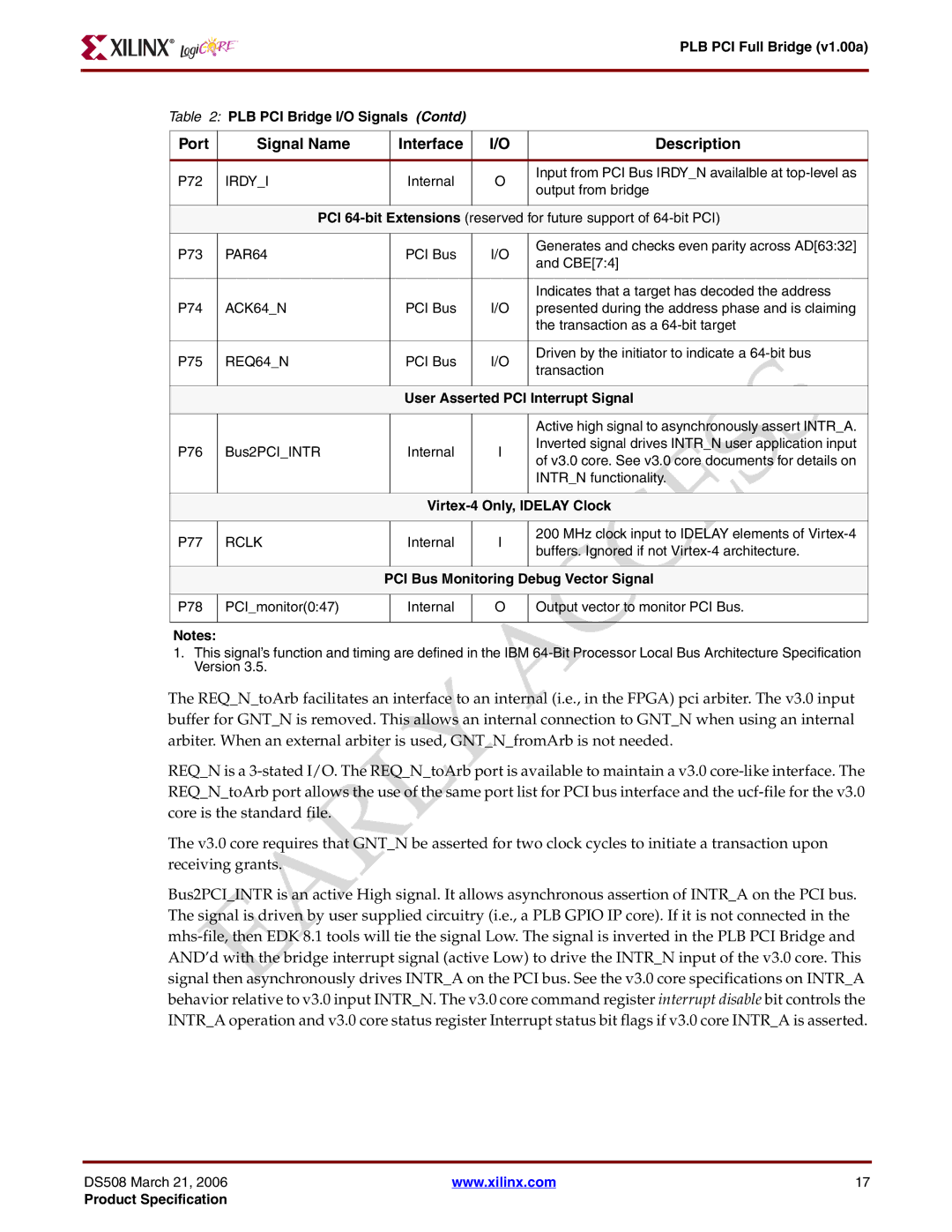
|
|
|
|
|
|
|
| PLB PCI Full Bridge (v1.00a) |
|
|
|
|
|
|
|
|
|
|
| Table 2: PLB PCI Bridge I/O Signals (Contd) |
|
| ||||
|
|
|
|
|
|
|
|
|
|
|
| Port | Signal Name |
| Interface | I/O | Description |
|
|
|
|
|
|
|
|
|
|
|
| P72 | IRDY_I |
| Internal | O | Input from PCI Bus IRDY_N availalble at |
|
|
|
| output from bridge | ||||
|
|
|
|
|
|
|
| |
|
|
|
|
|
|
|
| |
|
|
|
| PCI | ||||
|
|
|
|
|
|
|
|
|
|
|
| P73 | PAR64 |
| PCI Bus | I/O | Generates and checks even parity across AD[63:32] |
|
|
|
| and CBE[7:4] | ||||
|
|
|
|
|
|
|
| |
|
|
|
|
|
|
|
|
|
|
|
|
|
|
|
|
| Indicates that a target has decoded the address |
|
|
| P74 | ACK64_N |
| PCI Bus | I/O | presented during the address phase and is claiming |
|
|
|
|
|
|
|
| the transaction as a |
|
|
|
|
|
|
|
|
|
|
|
| P75 | REQ64_N |
| PCI Bus | I/O | Driven by the initiator to indicate a |
|
|
|
| transaction | ||||
|
|
|
|
|
|
|
| |
|
|
|
|
|
|
|
|
|
|
|
|
|
|
| User Asserted PCI Interrupt Signal | ||
|
|
|
|
|
|
|
|
|
|
|
|
|
|
|
|
| Active high signal to asynchronously assert INTR_A. |
|
|
| P76 | Bus2PCI_INTR |
| Internal | I | Inverted signal drives INTR N user application input |
|
|
|
| of v3.0 core. See v3.0 core documents for details on | ||||
|
|
|
|
|
|
|
| |
|
|
|
|
|
|
|
| INTR N functionality. |
|
|
|
|
|
|
|
|
|
|
|
|
|
|
|
| ||
|
|
|
|
|
|
|
|
|
|
|
| P77 | RCLK |
| Internal | I | 200 MHz clock input to IDELAY elements of |
|
|
|
| buffers. Ignored if not | ||||
|
|
|
|
|
|
|
| |
|
|
|
|
|
|
|
|
|
|
|
|
|
| PCI Bus Monitoring Debug Vector Signal | |||
|
|
|
|
|
|
|
|
|
|
|
| P78 | PCI_monitor(0:47) |
| Internal | O | Output vector to monitor PCI Bus. |
|
|
|
|
|
|
|
|
|
Notes:
1.This signal’s function and timing are defined in the IBM
The REQ_N_toArb facilitates an interface to an internal (i.e., in the FPGA) pci arbiter. The v3.0 input buffer for GNT_N is removed. This allows an internal connection to GNT N when using an internal arbiter. When an external arbiter is used, GNT_N_fromArb is not needed.
REQ_N is a
The v3.0 core requires that GNT N be asserted for two clock cycles to initiate a transaction upon receiving grants.
Bus2PCI_INTR is an active High signal. It allows asynchronous assertion of INTR_A on the PCI bus. The signal is driven by user supplied circuitry (i.e., a PLB GPIO IP core). If it is not connected in the
DS508 March 21, 2006 | www.xilinx.com | 17 |
Product Specification
